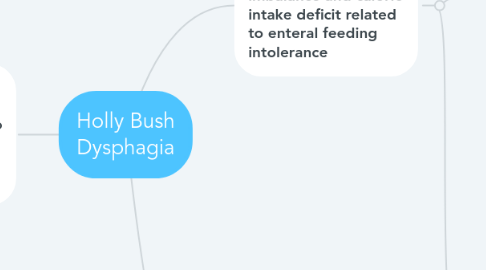
1. Nursing Diagnosis #1: Risk of fluid volume imbalance and caloric intake deficit related to enteral feeding intolerance
1.1. Assessment
1.1.1. Measurement of daily weights
1.1.1.1. Intervention & Rationale
1.1.1.1.1. Daily weights: fluid volume imbalance can be measured quickly and effectively by measuring daily body weight as fluctuations in weight are due to fluid changes rather than distribution changes of body fat or body muscle. Can be combined with other assessment information to determine the degree of fluid imbalance and determine if changes in feed and water flush schedule need to be made.
1.1.2. GI assessment
1.1.2.1. Intervention & Rationale
1.1.2.1.1. Monitor for presence of nausea, vomiting, diarrhea, pain, presence of bowel sounds in all abdominal quadrants, and abdominal distention. Nausea, vomiting, and diarrhea will alter amount of NG feed absorption in the body and place client at risk of dehydration and electrolyte imbalance. Pain and abdominal distention may be a sign of paralytic ileus or bowel obstruction which will affect feed absorption and place client at risk of regurgitation and aspiration. Abdominal distention and pain may also be a sign of accumulation of gas in the stomach
1.1.3. Integumentary assessment
1.1.3.1. Intervention & Rationale
1.1.3.1.1. Monitor mucous membranes and skin turgor for signs of fluid imbalance. Dry eyes and skin can be used a early signs of dehydration
1.1.4. Respiratory assessment
1.1.4.1. Intervention & Rationale
1.1.4.1.1. Monitor for changes in rate, rhythm and depth of breathing and breath sounds. Crackles are generally heard during severe fluid overload. Rate, rhythm and depth can be altered by fluid and electrolyte imbalance. Dehydration can cause increase rate of breathing Metabolic alkalosis due to vomiting and loss of acidic gastric acid can lead to rapid and shallowing breathing through respiratory compensation.
1.1.5. Vital signs
1.1.5.1. Intervention & Rationale
1.1.5.1.1. Heart rate and respiratory rate changes occur during periods of fluid and caloric intake imbalance so it is important to do frequent vital signs assessments to monitor for changes
1.2. Goal
1.2.1. Client will achieve optimal caloric and fluid intake as evidenced by maintaining adequate weight and nutritional status
2. Nursing Diagnosis #2: Ineffective airway clearance and aspiration risk related to presence of NG tube in the nasophyngeal tract and depression of the gag reflex
2.1. Assessment
2.1.1. Check placement of NG tube
2.1.1.1. Intervention & Rationale
2.1.1.1.1. Check placement before feeding, using X-ray, pH of gastric fluid, and measuring NG tube length as NG tube may displace into the lungs and cause risk for aspiration
2.1.2. Respiratory assessment & oxygen saturation
2.1.2.1. Intervention & Rationale
2.1.2.1.1. Monitor changes in respiratory rate, depth, and rhythm and respiratory sounds. Crackles in the lungs can be a sign of aspiration of feed into the lungs. Aspiration will also impair ventilation and the ability of the lungs to exchange oxygen
2.2. Goal
2.2.1. Client will maintain adequate airways as evidenced by no reflux emesis, no crackles, no abdominal distension during every enteral feeding
